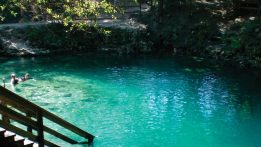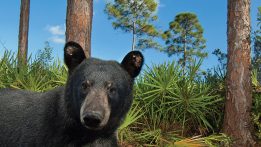 If you are someone who has dreamt of hiking a National Scenic Trail – a designated name for protected areas in the United States that consist of beautiful, natural trails – or you are looking for an exciting, new Florida experience, it may be more accessible than you think. Perhaps the Reese Witherspoon movie, Wild, inspired you to take on the Pacific Crest Trail. Or, the Continental Divide Trail has piqued your interest, with its punishing altitude and magnificent, sweeping vistas. Or maybe it is the great granddaddy of them all, the Appalachian Trail, which has ignited a hiking flame in you, capturing your imagination about what accomplishing this beast of a trail may feel like. Whatever your fancy, when it comes to hiking, you need not look much further than outside your very own doorstep.
If you are someone who has dreamt of hiking a National Scenic Trail – a designated name for protected areas in the United States that consist of beautiful, natural trails – or you are looking for an exciting, new Florida experience, it may be more accessible than you think. Perhaps the Reese Witherspoon movie, Wild, inspired you to take on the Pacific Crest Trail. Or, the Continental Divide Trail has piqued your interest, with its punishing altitude and magnificent, sweeping vistas. Or maybe it is the great granddaddy of them all, the Appalachian Trail, which has ignited a hiking flame in you, capturing your imagination about what accomplishing this beast of a trail may feel like. Whatever your fancy, when it comes to hiking, you need not look much further than outside your very own doorstep.
 Hiking one of the National Scenic Trails requires almost six months from start to completion, not to mention, another six months of training beforehand in addition to the thousands of dollars you will spend in equipment and supplies. If you are a more novice hiker, there is no sense in spending that kind of time and money when the Florida National Scenic Trail (FNST) is close by. Although not as popular as some of the other National Scenic Trails, many people see it fit to begin the FNST in January and hike the entire trail. It stretches all the way from the Big Cypress National Preserve, located in South Florida, to Fort Pickens on the Gulf Islands National Seashore, located near Pensacola. In total, the trail is about 1,300 miles long. The Tallahassee community is fortunate that some very beautiful parts of this trail go through our surrounding areas.
Hiking one of the National Scenic Trails requires almost six months from start to completion, not to mention, another six months of training beforehand in addition to the thousands of dollars you will spend in equipment and supplies. If you are a more novice hiker, there is no sense in spending that kind of time and money when the Florida National Scenic Trail (FNST) is close by. Although not as popular as some of the other National Scenic Trails, many people see it fit to begin the FNST in January and hike the entire trail. It stretches all the way from the Big Cypress National Preserve, located in South Florida, to Fort Pickens on the Gulf Islands National Seashore, located near Pensacola. In total, the trail is about 1,300 miles long. The Tallahassee community is fortunate that some very beautiful parts of this trail go through our surrounding areas.
The FNST was designed, built, and is currently being maintained by an organization known as the Florida Trail Association. In Tallahassee, there is a local chapter sector of this organization called the Apalachee Chapter. This chapter is responsible for preserving and protecting approximately 130 miles of the trail in this area, from a little bit west of the Aucilla River all the way to the Apalachicola River, which is even further west. The great thing about this section of trail is that there are many segments that can be hiked in just one day, or even a half-day, making it an accessible and fun activity to families and friends to enjoy. In order to hike this trail properly and smoothly, you will need a pair of comfortable, sturdy shoes, some trail snacks to munch on, sunscreen and insect repellent, and at least a liter of water. Shortly thereafter, you’ll be off on an adventure on one of the National Scenic Trails!
If you’re looking to take a day hike, you can visit the Florida Trail Association’s Apalachee Chapter website to view some noteworthy trails. Or, continue to read on to find out about a few accessible trails based on region.
 East of Tallahassee you will find two beautiful hiking trails that can be accessed from Goose Pasture Road in Jefferson County. If you follow the FNST north from this trailhead, you will shortly be hiking along the Aucilla River, a blackwater river with a great set of rapids. This trail follows alongside the river for about four miles, which equates to an eight mile hike in total out-and-back distance. If you aren’t looking to take that long of a hike, feel free to hike for as long as you can, then turn around and hike back to your car. Nearby, south of this trailhead, you will encounter a section known as the Aucilla Sinks, which is about four miles long. This is a significant historical and geographical area.
East of Tallahassee you will find two beautiful hiking trails that can be accessed from Goose Pasture Road in Jefferson County. If you follow the FNST north from this trailhead, you will shortly be hiking along the Aucilla River, a blackwater river with a great set of rapids. This trail follows alongside the river for about four miles, which equates to an eight mile hike in total out-and-back distance. If you aren’t looking to take that long of a hike, feel free to hike for as long as you can, then turn around and hike back to your car. Nearby, south of this trailhead, you will encounter a section known as the Aucilla Sinks, which is about four miles long. This is a significant historical and geographical area.
 Additionally, the St. Marks National Wildlife Refuge has a part of the FNST which crosses into this area from the east and the west. While the entire segment of the FNST on the refuge is 49.5 miles, you definitely don’t have to hike the entire thing. However, if you are looking to stay overnight, camping permits are available to hikers at their Visitor Center. While at the St. Marks National Wildlife Refuge you will find the Cathedral of Palms and Shepherd Spring, which is located between Wakulla Beach Road and Spring Creek Highway (CR 365). This trail passes through a very scenic area known as the Cathedral of Palms, which gets its name from the tall palm forest where fronds form a roof over a slice of the Big Bend, with a short side trail leading you to Shepherd Spring. This is one of my favorite hikes in the St. Marks National Wildlife Refuge, which can be done as a loop and is 5.6 to 7.7 miles long, depending on the route taken. The Cathedral of Palms is marked by towering trees called Cabbage Palms, also known as the Sabal Palmetto, as far as the eye can see. Shepherd Spring is a beautiful isolated spring and is one of the more scenic spots to spot and take a lunch break.
Additionally, the St. Marks National Wildlife Refuge has a part of the FNST which crosses into this area from the east and the west. While the entire segment of the FNST on the refuge is 49.5 miles, you definitely don’t have to hike the entire thing. However, if you are looking to stay overnight, camping permits are available to hikers at their Visitor Center. While at the St. Marks National Wildlife Refuge you will find the Cathedral of Palms and Shepherd Spring, which is located between Wakulla Beach Road and Spring Creek Highway (CR 365). This trail passes through a very scenic area known as the Cathedral of Palms, which gets its name from the tall palm forest where fronds form a roof over a slice of the Big Bend, with a short side trail leading you to Shepherd Spring. This is one of my favorite hikes in the St. Marks National Wildlife Refuge, which can be done as a loop and is 5.6 to 7.7 miles long, depending on the route taken. The Cathedral of Palms is marked by towering trees called Cabbage Palms, also known as the Sabal Palmetto, as far as the eye can see. Shepherd Spring is a beautiful isolated spring and is one of the more scenic spots to spot and take a lunch break.
 The Apalachee Chapter’s section of the FNST also passes through the St. Marks National Wildlife Refuge. The FNST crosses Lighthouse Road about two miles south of the Visitor Center. If you hike to the east you will encounter some sweeping vistas of the Big Bend Region after about a three-mile walk. If you hike to the west, you will pass some great waterfowl viewing areas. After about a mile and a half, the FNST turns left and runs along the Port Leon Road. Near the west end of the road, there is a blue-blazed side trail to the site of the old port on the Wakulla River. All of these routes provide great views and even better exercise.
The Apalachee Chapter’s section of the FNST also passes through the St. Marks National Wildlife Refuge. The FNST crosses Lighthouse Road about two miles south of the Visitor Center. If you hike to the east you will encounter some sweeping vistas of the Big Bend Region after about a three-mile walk. If you hike to the west, you will pass some great waterfowl viewing areas. After about a mile and a half, the FNST turns left and runs along the Port Leon Road. Near the west end of the road, there is a blue-blazed side trail to the site of the old port on the Wakulla River. All of these routes provide great views and even better exercise.
If you travel further west through Florida, the FNST enters the Apalachicola National Forest. At one point, it follows the Sopchoppy River for about four miles. Many people like to do this hike in the spring when the wild azaleas are in bloom. However, my favorite time is the fall because the leaf colors are simply spectacular. It is definitely a trail you should check out.
 If hiking trails on the FNST isn’t your cup of tea, don’t despair, because there are other options available to get your hike on. The Apalachee Chapter of the Florida Trail Association maintains many other trails; my favorites can be found in three separate locations. Torreya State Park has two loop trails that are in total about seven miles long. These are two of the most challenging trails to be found in the state of Florida. In addition to that, Ft. Braden Trails in Lake Talquin State Forest, about ten miles west of downtown Tallahassee, has three loop trails. They can be done separately – the shortest being two and a half miles – or combined for a total mileage of about nine and a half miles. Finally, if you live in Tallahassee, Elinor Klapp-Phipps Park is basically right in your backyard. It also has loop trails, the shortest of which is only a little over a mile, but in total they amount to approximately a seven-mile hike.
If hiking trails on the FNST isn’t your cup of tea, don’t despair, because there are other options available to get your hike on. The Apalachee Chapter of the Florida Trail Association maintains many other trails; my favorites can be found in three separate locations. Torreya State Park has two loop trails that are in total about seven miles long. These are two of the most challenging trails to be found in the state of Florida. In addition to that, Ft. Braden Trails in Lake Talquin State Forest, about ten miles west of downtown Tallahassee, has three loop trails. They can be done separately – the shortest being two and a half miles – or combined for a total mileage of about nine and a half miles. Finally, if you live in Tallahassee, Elinor Klapp-Phipps Park is basically right in your backyard. It also has loop trails, the shortest of which is only a little over a mile, but in total they amount to approximately a seven-mile hike.
One of the best parts about hiking is that it’s a great physical activity and can give you that much-needed mental release. You can hike alone to decompress, or if you prefer to hike with a group, the Apalachee Chapter offers free guided hikes of all descriptions, lengths and speeds. You can find a listing of the time and dates on their website at apalachee.floridatrail.org. So you know, the Apalachee Chapter also offers more hiking opportunities in the fall, winter and spring than in summer, so be sure to check back when the cooler weather comes around. ![]()
By Dawn Brown
Chapter Chairperson
Apalachee Chapter, Florida Trail Association




